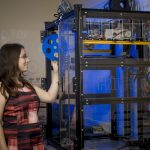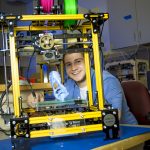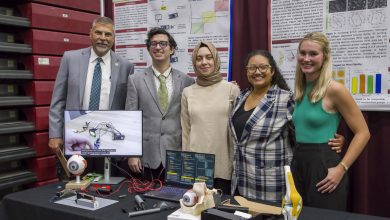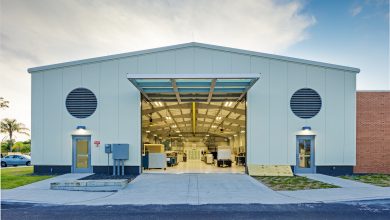Project Based Learning: Gateway to Innovation
Electrical engineering major Tabitha Beavers ‘15 might never have known her body was quietly and painlessly afflicted with Brugada Syndrome if her doctor hadn’t double-checked the position of an electric sensor patch during an ECG monitoring test.
Brugada is a rare genetic disease that, if not properly treated, increases one’s risk for sudden cardiac failure. “I was only a half inch between life and death,” says Tabitha. “My doctor could have just as easily not moved the electrode.”
The problem, Tabitha discovered, is that even properly applied ECG sensors may not pick up on the more difficult to diagnose cardiac abnormalities, like Brugada Syndrome.
“My doctor adjusted the electrode because my family has a history of heart conditions,” she says. “But what about people without family histories? What about people with less-thorough doctors? You shouldn’t have to specifically look for a rare disease if there are no symptoms. I had to find a solution.”
Problem Solving Through Project-Based Learning
Thus began Tabitha’s journey toward building a better sensor. Giving little thought to how difficult her goal might be, the junior spent countless hours researching ECG technologies, consulting with mentors, and taking advantage of Florida Tech resources to plan and build a prototype. The end result? A machine-learning electrode designed to increase placement accuracy.
Tabitha’s design has the potential to pick up hard-to-detect happenings, lifting the veil on data doctors haven’t previously been able to access, and likely saving lives. But fame and fortune are far from the young innovator’s thoughts.
“I identified a need, then I put my passion for engineering to work in meeting that need,” says Tabitha. “That’s just how we operate.”
People as bright, creative and resourceful as Tabitha are generally few and far between, but she’s in good company at Florida Tech.
Learn more about her Student Design Project:

Project Based Learning Innovation
With one patent under his belt (for a particle accelerator he designed and built in high school), Chris Ballantine is simultaneously pursuing degrees in electrical engineering, mechanical engineering and computer engineering with minors in physics, entrepreneurship and computer science. The combination of engineering and business helps keep Chris mindful of commercialization when coming up with new ideas, he says.
Currently, Chris is working on three such ideas. He has a thermal modeling system he says will aid in the creation of more practical small designs, a software solution for text to speech, and a cost-effective 3D SLS printer that outputs in various types of metal.
One vital component of Chris’s 3D printer is an O2 sensor, without which the printer could collect too much oxygen and eventually combust. But like Tabitha’s electrode, the sensor Chris needed didn’t exist. So like Tabitha, he’s had to research, design and build one himself. As a result, Chris is well on his way to a second patent—this time, for a novel oxygen sensor design.
Innovating the Future
Tabitha and Chris represent the ever-growing number of Florida Tech students who aren’t afraid to ask bold questions, crowd-source intelligence, and break new ground in response to unmet needs. This kind of innovation may be disruptive to the status quo, but certainly it’s in the best way possible.

By approaching math, business, science and engineering through project-based learning, these students and others are chipping away at old ways of thinking, building and learning. Together, they are pressing the reset button, crumbling old paradigms and cutting new paths to frontiers that, until recently, didn’t even exist.
You can follow Tabitha and her new non-profit makerspace: Project-Based Learning, Inc. on their website, or click here to go behind the scenes.







